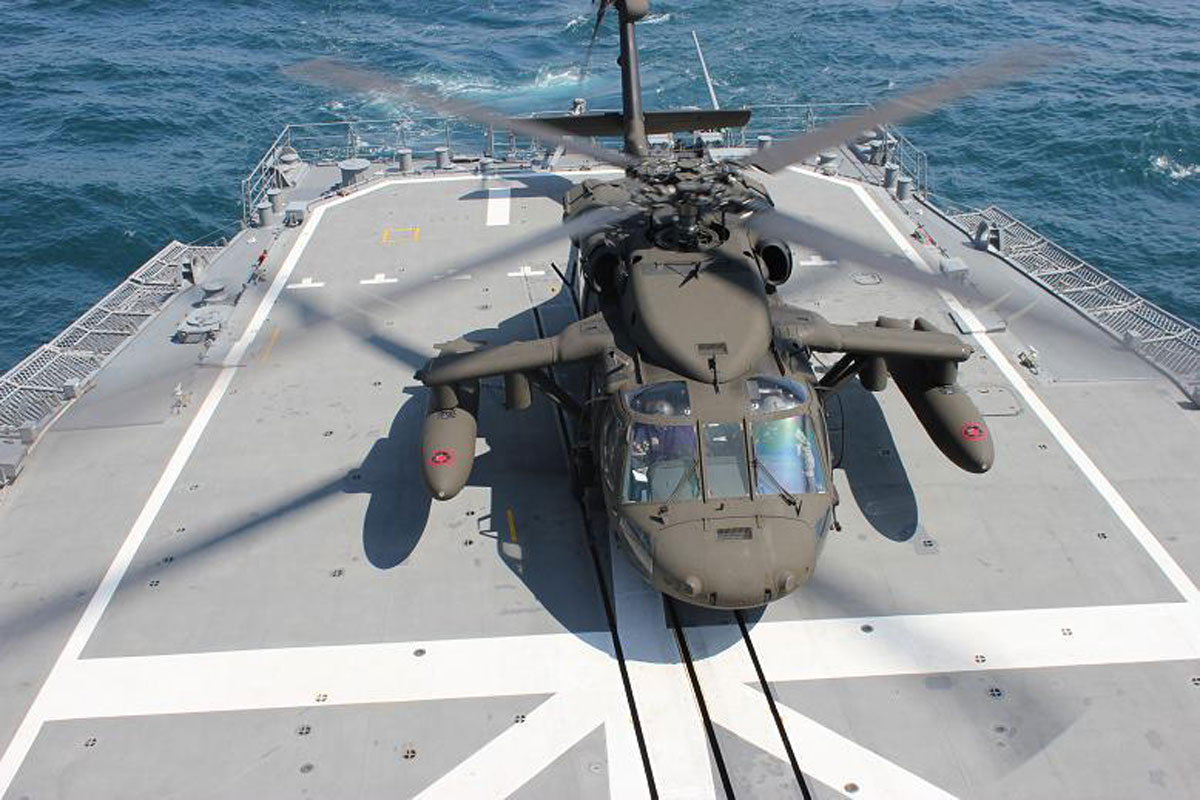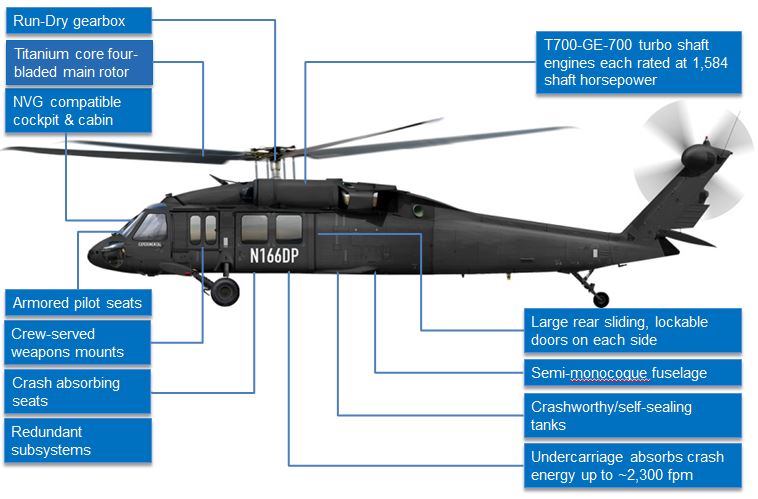The UH 60 and Its Payment to Airborne Operations in Important Objectives
The UH 60 and Its Payment to Airborne Operations in Important Objectives
Blog Article
UH-60: Innovations in Modern Helicopter Design
The UH-60 helicopter stands as a benchmark in contemporary aeronautics, showcasing considerable advancements in layout and modern technology that accommodate the advancing needs of army procedures. Its unification of sophisticated materials not just improves efficiency but likewise addresses vital safety and security issues. Additionally, the combination of innovative avionics has actually transformed functional capacities, permitting higher situational understanding and decision-making efficiency. As we explore the advancement and key developments of the UH-60, it becomes vital to consider exactly how these advancements influence not only current applications but also the future landscape of helicopter layout.

Advancement of the UH-60
The development of the UH-60 Black Hawk helicopter stands for a significant turning point in aerospace design and armed forces aeronautics. Introduced in the late 1970s, the UH-60 was developed by Sikorsky Airplane to satisfy the United States Army's requirement for a versatile utility helicopter capable of performing a selection of goals. Its layout emphasized durability, ability to move, and speed, establishing brand-new requirements for functional performance.
The UH-60 includes a distinct four-blade rotor system, which improves lift and stability, allowing it to operate efficiently in varied atmospheres. Its airframe is created from innovative composite materials, contributing to a reduction in weight while maintaining structural honesty. The helicopter's design also includes enhanced the rules of aerodynamics, which enhances fuel efficiency and boosts array.
For many years, the Black Hawk has undertaken numerous upgrades to improve its abilities, consisting of boosted engines, progressed trip control systems, and modular systems for easy maintenance and flexibility. The helicopter's capability to do missions ranging from army transport to medical emptying has actually strengthened its function as a backbone of U.S. armed forces operations. The UH-60 Black Hawk remains an archetype of how advancement in helicopter layout can dramatically impact armed forces effectiveness and operational versatility.
Advanced Avionics Solutions
Improvements in avionics systems have changed the abilities of modern helicopters like the UH-60 Black Hawk, enhancing operational performance and situational recognition (UH 60). The integration of advanced avionics enables for improved trip, navigation, and communication management, making the UH-60 a lot more functional in diverse objective profiles
Among the essential features is the sophisticated digital cabin, which uses multifunction displays that supply real-time information, making certain pilots have immediate access to essential flight info. This streamlining of details minimizes pilot work and improves decision-making procedures throughout complex procedures. Furthermore, the unification of general practitioner and inertial navigation systems enables exact positioning and route preparation, enhancing goal execution in difficult settings.
In addition, progressed avionics systems boost communication capacities with safe data links and voice communication systems, allowing smooth sychronisation with ground forces and other aircraft. The combination of automatic flight control systems additionally adds to enhanced security and control, especially in negative climate condition or throughout low-altitude maneuvers.
Engine and Efficiency Enhancements
Engine efficiency in contemporary helicopters has taken a significant jump forward, driven by developments that boost performance, power, and integrity. The UH-60 Black Hawk, for instance, makes use of the T700-GE-701C engine, which features a dual-channel, full-authority digital engine control system.
Furthermore, the integration of engine health and wellness surveillance systems enables for real-time diagnostics and anticipating maintenance, considerably enhancing functional dependability. These systems not just alert crews to potential concerns prior to they end up being critical yet also promote a lot more effective upkeep organizing, consequently minimizing downtime.

Materials and Structural Innovations
Recent developments in materials my response and architectural layout have actually transformed modern helicopter construction, enhancing both performance and sturdiness. The introduction of advanced composite materials, such as carbon fiber strengthened polymers, has dramatically minimized weight while keeping architectural stability. This shift not just enhances fuel efficiency yet also enhances haul ability, enabling helicopters like the UH-60 to perform more diverse objectives.
Furthermore, technologies in aluminum alloys and titanium components have actually added to enhanced resistance to deterioration and exhaustion, expanding the lifespan of essential airframe aspects. The calculated use these materials has actually resulted in a decrease in upkeep needs and enhanced overall functional preparedness.

Moreover, the assimilation of computer-aided style (CAD) and additive production innovations has allowed more lightweight frameworks and complicated geometries, maximizing the wind resistant efficiency of helicopter styles. These advancements assist in rapid prototyping and manufacturing, enabling manufacturers to respond quickly to progressing mission requirements.
Safety and Survivability Attributes
Security and survivability features in contemporary helicopter layout have ended up being vital, showing the enhancing needs for mission effectiveness in challenging settings. The UH-60 Black Hawk, a significant example, integrates sophisticated innovations to improve crew and traveler protection. Among the most critical advancements is the incorporation of crashworthy gas systems made to decrease the danger of fire during effect. In addition, the airframe is built with enhanced products that dissipate and take in power, additional safeguarding owners in the occasion of an accident.
The helicopter likewise employs a ballistic protection system, which includes armored crew seats and vital systems securing, lowering susceptability to tiny arms fire and shrapnel. Improved situational awareness is accomplished with sophisticated avionics and sensing unit technologies, allowing pilots to identify and prevent hazards efficiently.
In addition, the integration of redundancy in vital systems-- such as dual engines and several flight control networks-- makes sure continued operation even if one system stops working. The UH-60 is geared up with advanced emergency situation flotation devices, boosting look at here survivability in water landings. Jointly, these features not only enhance the security of workers yet also enhance objective success prices in hostile settings, showing the dedication to excellence in helicopter design.
Verdict
The UH-60 helicopter represents a considerable improvement in contemporary aviation technology, including ingenious materials, cutting-edge avionics, and durable safety and security functions. Its development mirrors a dedication to enhancing efficiency and functional effectiveness while making certain pilot and team survivability. The combination of lightweight composites and advanced navigating systems highlights the helicopter's versatility in numerous armed forces objectives. Generally, the UH-60 functions as a criteria for future advancements in helicopter layout, embodying strength and adaptability in contemporary army operations.
The UH-60 helicopter stands as a standard in modern-day aeronautics, showcasing significant developments in layout and innovation that provide to the developing demands of armed forces operations. As we check out the development and vital developments of the UH-60, it becomes necessary to consider just how these developments affect not just current applications but also the future landscape of helicopter style.
Introduced in the late 1970s, the UH-60 was designed by Sikorsky Airplane to meet the United States Army's demand for a functional utility helicopter capable of executing a variety of missions. The UH-60 Black Hawk continues to be a prime instance of exactly how advancement in helicopter design can considerably impact military performance and operational versatility.
On the whole, the UH-60 serves as a standard for future growths in helicopter layout, symbolizing resilience and adaptability in contemporary army operations.
Report this page